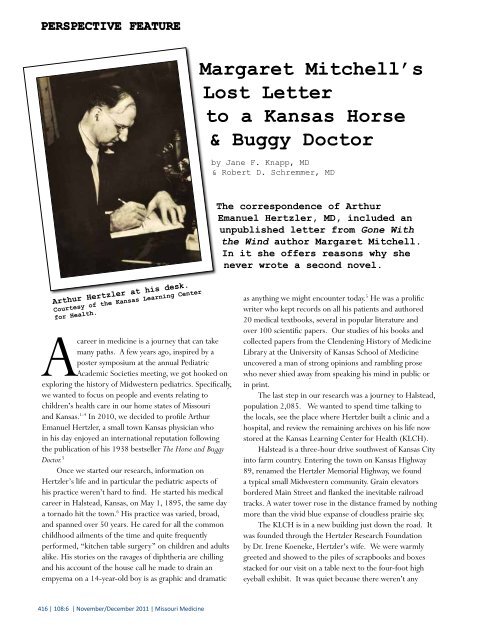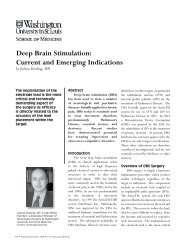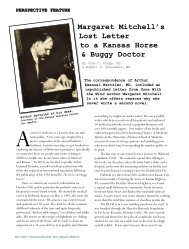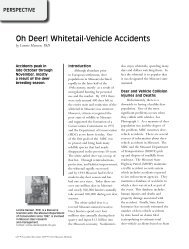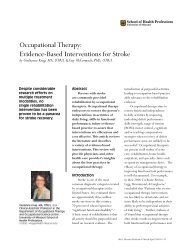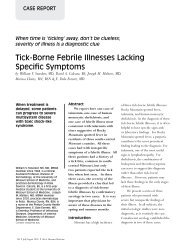Margaret Mitchell's Lost Letter to a Kansas Horse & Buggy Doctor
Margaret Mitchell's Lost Letter to a Kansas Horse & Buggy Doctor
Margaret Mitchell's Lost Letter to a Kansas Horse & Buggy Doctor
Create successful ePaper yourself
Turn your PDF publications into a flip-book with our unique Google optimized e-Paper software.
PersPective Feature<br />
arthur Hertzler at his desk.<br />
courtesy of the <strong>Kansas</strong> Learning center<br />
for Health.<br />
A<br />
career in medicine is a journey that can take<br />
many paths. A few years ago, inspired by a<br />
poster symposium at the annual Pediatric<br />
Academic Societies meeting, we got hooked on<br />
exploring the his<strong>to</strong>ry of Midwestern pediatrics. Specifically,<br />
we wanted <strong>to</strong> focus on people and events relating <strong>to</strong><br />
children’s health care in our home states of Missouri<br />
and <strong>Kansas</strong>. 1-4 In 2010, we decided <strong>to</strong> profile Arthur<br />
Emanuel Hertzler, a small <strong>to</strong>wn <strong>Kansas</strong> physician who<br />
in his day enjoyed an international reputation following<br />
the publication of his 1938 bestseller The <strong>Horse</strong> and <strong>Buggy</strong><br />
Doc<strong>to</strong>r. 5<br />
Once we started our research, information on<br />
Hertzler’s life and in particular the pediatric aspects of<br />
his practice weren’t hard <strong>to</strong> find. He started his medical<br />
career in Halstead, <strong>Kansas</strong>, on May 1, 1895, the same day<br />
a <strong>to</strong>rnado hit the <strong>to</strong>wn. 6 His practice was varied, broad,<br />
and spanned over 50 years. He cared for all the common<br />
childhood ailments of the time and quite frequently<br />
performed, “kitchen table surgery” on children and adults<br />
alike. His s<strong>to</strong>ries on the ravages of diphtheria are chilling<br />
and his account of the house call he made <strong>to</strong> drain an<br />
empyema on a 14-year-old boy is as graphic and dramatic<br />
416 | 108:6 | November/December 2011 | Missouri Medicine<br />
<strong>Margaret</strong> Mitchell’s<br />
<strong>Lost</strong> <strong>Letter</strong><br />
<strong>to</strong> a <strong>Kansas</strong> <strong>Horse</strong><br />
& <strong>Buggy</strong> Doc<strong>to</strong>r<br />
by Jane F. Knapp, MD<br />
& Robert D. Schremmer, MD<br />
the correspondence of arthur<br />
emanuel Hertzler, MD, included an<br />
unpublished letter from Gone With<br />
the Wind author <strong>Margaret</strong> Mitchell.<br />
in it she offers reasons why she<br />
never wrote a second novel.<br />
as anything we might encounter <strong>to</strong>day. 5 He was a prolific<br />
writer who kept records on all his patients and authored<br />
20 medical textbooks, several in popular literature and<br />
over 100 scientific papers. Our studies of his books and<br />
collected papers from the Clendening His<strong>to</strong>ry of Medicine<br />
Library at the University of <strong>Kansas</strong> School of Medicine<br />
uncovered a man of strong opinions and rambling prose<br />
who never shied away from speaking his mind in public or<br />
in print.<br />
The last step in our research was a journey <strong>to</strong> Halstead,<br />
population 2,085. We wanted <strong>to</strong> spend time talking <strong>to</strong><br />
the locals, see the place where Hertzler built a clinic and a<br />
hospital, and review the remaining archives on his life now<br />
s<strong>to</strong>red at the <strong>Kansas</strong> Learning Center for Health (KLCH).<br />
Halstead is a three-hour drive southwest of <strong>Kansas</strong> City<br />
in<strong>to</strong> farm country. Entering the <strong>to</strong>wn on <strong>Kansas</strong> Highway<br />
89, renamed the Hertzler Memorial Highway, we found<br />
a typical small Midwestern community. Grain eleva<strong>to</strong>rs<br />
bordered Main Street and flanked the inevitable railroad<br />
tracks. A water <strong>to</strong>wer rose in the distance framed by nothing<br />
more than the vivid blue expanse of cloudless prairie sky.<br />
The KLCH is in a new building just down the road. It<br />
was founded through the Hertzler Research Foundation<br />
by Dr. Irene Koeneke, Hertzler’s wife. We were warmly<br />
greeted and showed <strong>to</strong> the piles of scrapbooks and boxes<br />
stacked for our visit on a table next <strong>to</strong> the four-foot high<br />
eyeball exhibit. It was quiet because there weren’t any
school <strong>to</strong>urs that day; a perfect time for poring through old<br />
records.<br />
It didn’t take long <strong>to</strong> discover the letter from<br />
<strong>Margaret</strong> Mitchell on her personalized stationary dated<br />
September 7, 1944. (See Figure 1, next page.) Our first<br />
thoughts inevitably were, “The Gone With the Wind <strong>Margaret</strong><br />
Mitchell?” It was soon<br />
apparent that it was indeed<br />
the <strong>Margaret</strong> Mitchell,<br />
and that she was a fan as<br />
she put it “of Hertzler’s<br />
pungent writing style.”<br />
Based on our collective<br />
knowledge of Arthur’s<br />
writing, we easily related.<br />
The letter was obviously<br />
from one writer <strong>to</strong> another<br />
and typified her special<br />
talent as a s<strong>to</strong>ryteller.<br />
She began by referring <strong>to</strong><br />
Hertzler’s book Ventures in<br />
Science of a Country Surgeon. 7<br />
Toward the end of the<br />
book, in a chapter entitled,<br />
“The Writing of Books,”<br />
he notes that he had been<br />
introduced <strong>to</strong> <strong>Margaret</strong><br />
Mitchell, and described her<br />
as, “the most remarkable<br />
person I have ever met.” 7<br />
The next <strong>to</strong> last<br />
paragraph piqued our<br />
curiosity. In her letter, <strong>Margaret</strong> Mitchell tells Arthur<br />
Hertzler why, as of 1944, she had not written another<br />
book. On further reading we learned that biographers<br />
have well chronicled her father Eugene Mitchell’s ill health,<br />
protracted decline and <strong>Margaret</strong>’s immersion in his care.<br />
8, 9 They have also recounted multiple other stressors,<br />
including her struggle <strong>to</strong> cope with the no<strong>to</strong>riety and<br />
complexities of her life following the publication of Gone<br />
With the Wind, her own poor health, and her husband’s<br />
frailty. Interestingly, after her death in 1949 her husband<br />
and brother wrote <strong>to</strong> her correspondents requesting that<br />
they destroy her letters 9 but Arthur had died in 1946 soon<br />
after retirement. That letter, tucked away in <strong>Kansas</strong> for<br />
decades, provides the opportunity <strong>to</strong> revisit <strong>Margaret</strong>’s<br />
thoughts on writing again with the clarity and poignancy of<br />
her own words. In a <strong>to</strong>uch of irony she ended by urging<br />
him <strong>to</strong> write more.<br />
<strong>Margaret</strong> Mitchell, circa 1941.<br />
source: u.s. Library of congress.<br />
PersPective Feature<br />
The letter from <strong>Margaret</strong> Mitchell wasn’t the only<br />
find. There was a copy of a letter from Albert Einstein<br />
dated June 24, 1944, in which he thanks Hertzler for<br />
sending him a copy of The Grounds of an Old Surgeons<br />
Faith. 10 A retinue of the 1941 Chicago Cubs sent a letter<br />
au<strong>to</strong>graphed by players, coaches, the manager, trainer,<br />
and newspapermen thanking<br />
him for the steaks he supplied <strong>to</strong><br />
their dining car during a train trip<br />
through Wichita. They also sent<br />
along a thick packet of au<strong>to</strong>graphed<br />
individual and group pictures;<br />
there’s a good one of Dizzy Dean.<br />
Fellow Kansan Karl Menninger sent<br />
a letter congratulating Hertzler<br />
on his career achievements when<br />
Arthur retired in 1946. The<br />
letters left us flush with the thrill<br />
of discovery, but also struck by<br />
this sturdy and enduring form<br />
of communication much richer<br />
in composition than the hastily<br />
deleted e-mails and superficial texts<br />
and tweets of <strong>to</strong>day.<br />
Ultimately, the most rewarding<br />
part of this journey in<strong>to</strong> his<strong>to</strong>ry<br />
was the visit <strong>to</strong> Halstead. For<br />
it was there that we gained an<br />
understanding of Arthur Hertzler,<br />
the person behind the books.<br />
Before we left we viewed the<br />
glass display cases filled with<br />
memorabilia in the back of the<br />
museum. There among the old medical instruments was a<br />
large leather bound copy of De Humani Corporis Fabrica Libri<br />
Decem the ana<strong>to</strong>my text by Adriani Spigelii (also known as<br />
Adriaan van den Spiegel), published in Venice in 1627. 11<br />
From signatures in the front of the book it appears <strong>to</strong> have<br />
once been owned by Franz Leydig. Hertzler was a serious<br />
student of ana<strong>to</strong>my. In 1899, he <strong>to</strong>ok a two-year hiatus<br />
from his practice <strong>to</strong> study ana<strong>to</strong>my and surgical pathology<br />
with Virchow and Waldeyer in Berlin. In the <strong>Horse</strong> and<br />
<strong>Buggy</strong> Doc<strong>to</strong>r he writes of his great respect for his teachers<br />
and notes that, “no American teacher ever showed me the<br />
many favors that many of these German professors did.”<br />
5 We saw the picture of his beloved daughter, Agnes, the<br />
black-eyed girl that he refers <strong>to</strong> several times in The <strong>Horse</strong><br />
and <strong>Buggy</strong> Doc<strong>to</strong>r. Agnes, we learned through personal<br />
communication with KLCH staff, died at 18 during an<br />
appendec<strong>to</strong>my being performed by her father. The s<strong>to</strong>ry of<br />
Missouri Medicine | November/December 2011 | 108:6 | 417
<strong>Margaret</strong> Mitchell<br />
Atlanta, Georgia<br />
September, 1944<br />
Dear Doc<strong>to</strong>r Hertzler:<br />
Last night I began picking about in “Ventures in Science of a Country Surgeon,” for I<br />
have the bad habit of never starting a book at the beginning and reading it <strong>to</strong> the end. As<br />
a child I was reproved for picking all the raisins out of puddings and eating them first, and<br />
I have not improved much since then. After eating the raisins I always ate all the pudding,<br />
<strong>to</strong>o, so I could never understand why my practice was reprehensible. While putting in my<br />
fingers <strong>to</strong> pull out a medical raisin, whom should I find but myself. To say I was surprised is<br />
a very great understatement. To say I was pleased and flattered at what you said is such an<br />
understatement I scarcely have the courage <strong>to</strong> put it down. I ate this raisin immediately and<br />
enjoyed it very much and thank you so much for your forthright remark.<br />
I not only get information from your medical books but I get vast entertainment. I<br />
do not know anyone who writes as pungently as you do. Nor do I know anyone who can use a<br />
meat exe on the pompous or the misguided or the overstuffed with such deadly aim. I know I<br />
should not get so much pleasure and laughter from books as serious as yours, but I do and must<br />
confess it. I think you must be an extraordinarily able teacher with never a dull moment in<br />
your classes, for you have a vigorous mind and you certainly speak it.<br />
I had enjoyed Chronic Appendicitis enormously, for I have the rare good luck of having<br />
an old fashioned doc<strong>to</strong>r for a friend and I have heard him express himself in similar terms<br />
on this same subject. I read parts of it <strong>to</strong> my husband, who listened with interest equal <strong>to</strong><br />
mine. Then, picking about in the section, Ventures in Therapeutics, my eyes fell upon the<br />
words “sciatica and compressed nerves.” I read this section aloud, <strong>to</strong>o, and I cannot tell you<br />
how enchanted my husband and I were by what you wrote. I would like <strong>to</strong> say that I “rolled<br />
on the floor” at your remarks about the specialists and their work upon the spine, but, dear<br />
Doc<strong>to</strong>r, I do not roll on the floor these days, nor roll anywhere, because I am one of those<br />
people who had my intervertebral disks worked on eighteen months ago and am in far worse shape<br />
than before. However, I suppose that I am mentally in fine condition, for I can laugh about<br />
this section of your book when <strong>to</strong>o deep a laugh is not very pleasant. The doc<strong>to</strong>r who yanked<br />
out my disk is inviting me back <strong>to</strong> the hospital <strong>to</strong> do the operation over, and when he issues<br />
his next invite I think I’ll quote him, line and page, from your book. After I had read my<br />
husband the part about you and the hash and the s<strong>to</strong>mach pump and the cardia, he had <strong>to</strong> take<br />
off his glasses and wipe them because he had laughed till he had cried. He said that you must<br />
be one of the most remarkable people in shoe leather <strong>to</strong> be able <strong>to</strong> make your point about the<br />
strength of these muscles with such vividness. “The Doc<strong>to</strong>r is a salty cuss,” he said, “and you<br />
certainly were lucky <strong>to</strong> meet him. I only wish I had the chance <strong>to</strong> know him myself.”<br />
I did not write you after I had read your book on the “Diseases of the Thyroid Gland,”<br />
but it was not through lack of interest. I read it slowly and with care, harassing the old<br />
fashioned friend I mentioned above for meanings of medical terms and explanations of surgical<br />
technique which no layman can know. That is an impressive volume, impressive especially when<br />
I think of the many years’ study and thought which went in<strong>to</strong> making it. If you had no other<br />
monument except this it would be a greater monument than most men can ever hope for, but here<br />
you go along writing other books just as good!<br />
I had intended <strong>to</strong> write you about the thyroid book, but my father died in June and<br />
I did not have time or the heart. He had been ill so long---six years in all, and the last<br />
three in the hospital. He would not have a kidney s<strong>to</strong>ne removed many years ago when he was<br />
in excellent health and he delayed far <strong>to</strong>o long in having a prostatic operation. Three years<br />
ago we did not expect him <strong>to</strong> live another week, and for his sake I wish it had been that way.<br />
He had the constitution of an ox and just how he stayed alive his doc<strong>to</strong>rs did not know. I’m<br />
sure you’ve seen uremia and abscessed kidneys and <strong>to</strong>xemia and pneumonia enough so that I do<br />
not have <strong>to</strong> tell you what those years were. When people ask why I have not written another<br />
book, I look at them in wonder, for how can one do creative work in a constant worry like this<br />
or when physical fatigue reaches the point of exhaustion every day. I hope that my own health<br />
will improve now that I do not have <strong>to</strong> bend over high hospital beds or fix pillows or lift or<br />
strain. I’ve had it on my mind so often <strong>to</strong> thank you for that book, for I really got a lot out<br />
of it.<br />
You do not fool me at all and I do not think you are fooling yourself by your statement<br />
in the front of your “Ventures”---“this is probably my last book.” I know there’ll be plenty<br />
of others.<br />
Cordially,
her tragic death supplied the here<strong>to</strong>fore missing<br />
perspective in<strong>to</strong> Arthur’s pungent writing style.<br />
It also provided us insight in<strong>to</strong> the personal loss<br />
that we now unders<strong>to</strong>od, from other papers we<br />
examined at the KLCH, haunted him throughout<br />
his life.<br />
Our poster on The Life and Times of a <strong>Kansas</strong><br />
<strong>Horse</strong> and <strong>Buggy</strong> Doc<strong>to</strong>r and His Recollections on<br />
the Care of Children was presented at the 2011<br />
Pediatric Academic Societies Meeting. 12 It<br />
focused on Arthur’s professional career as a<br />
physician on the <strong>Kansas</strong> prairie in a time when<br />
it <strong>to</strong>ok stamina and grit <strong>to</strong> reach your patients<br />
and skill, experience and ingenuity once you<br />
got there. It recounted s<strong>to</strong>ries of his care for<br />
children whom he said, “always came first.” 5<br />
But, our poster didn’t tell the less public s<strong>to</strong>ry<br />
we found preserved in the letters, scrapbooks,<br />
displays and oral his<strong>to</strong>ry of Halstead. It seemed a<br />
shame not <strong>to</strong> share it.<br />
references<br />
1. Schremmer RD, Knapp JF. Herbert A. Wenner, Polio, and the<br />
Fort Knox of Virology. (abstract) EPAS2008:3220.8.<br />
2. Schremmer RD, Knapp JF, Hellerstein S. Dan Darrow: The<br />
<strong>Kansas</strong> City Years. (abstract) EPAS2009:2145.13.<br />
3. Schremmer RD, Knapp JF. Give ‘Em Healthcare Harry:<br />
It Started with the Man from Independence. (abstract)<br />
EPAS2010:1352.5.<br />
4. Schremmer RD, Knapp JF. Harry Truman and health care<br />
reform: the debated started here. Pediatrics 2011; 98:497-499.<br />
5. Hertzler AE. The <strong>Horse</strong> and <strong>Buggy</strong> Doc<strong>to</strong>r. 1st ed. New York, NY: Harper & Brothers: 1938.<br />
6. Hertzler JJ. Arthur E. Hertzler the <strong>Kansas</strong> horse and buggy doc<strong>to</strong>r: a biographical sketch.<br />
Journal of the <strong>Kansas</strong> Medical Society 1962; 63(10):424-433.<br />
7. Hertzler AE. Ventures in Science of a Country Surgeon. Halstead, KS: published by<br />
the author: 1944.<br />
8. Pyron DA. Southern Daughter: The Life of <strong>Margaret</strong> Mitchell. New York: Oxford<br />
University Press: 1991.<br />
9. Edwards A. Road <strong>to</strong> Tara: The Life of <strong>Margaret</strong> Mitchell. New Haven, Conn: Ticknor<br />
and Fields: 1983.<br />
10. Hertzler AE. The Grounds of an Old Surgeons Faith. Wichita, KS: Wichita Eagle Press: 1944.<br />
11. Spigelii A. De Humani Corporis Fabrica Libri Decem. Venice: Evangelista Deuchino: 1627.<br />
12. Schremmer RD, Knapp JF. The Life and Times of a <strong>Kansas</strong> <strong>Horse</strong> and <strong>Buggy</strong> Doc<strong>to</strong>r and His<br />
Recollections on the Care of Children. (abstract) EPAS2011:1160.5<br />
acknowledgment<br />
The authors would like <strong>to</strong> acknowledge the assistance of Brenda<br />
Sooter, Executive Direc<strong>to</strong>r, the staff and the Board of Direc<strong>to</strong>rs of the<br />
<strong>Kansas</strong> Learning Center for Health for their assistance in our research<br />
and the preparation of this manuscript, and www.halsteadks.com.<br />
Figure 1 (opposite page)<br />
scanned copy of <strong>Margaret</strong> Mitchell’s letter <strong>to</strong><br />
author Hertzler. courtesy of the <strong>Kansas</strong> Learning center<br />
for Health. recreated for Missouri Medicine.<br />
Hertzler Memorial Highway sign on the outskirts<br />
of Halstead, Ks. Pho<strong>to</strong> by r. schremmer, MD.<br />
Jane F. Knapp, MD, MSMA<br />
member since 1989, is Chair<br />
or the Department of Medical<br />
Education and Associate Chair<br />
of Pediatrics at Children’s<br />
Mercy Hospitals and Clinics<br />
in <strong>Kansas</strong> City, and Associate<br />
Dean at the University of<br />
Missouri-<strong>Kansas</strong> City School<br />
of Medicine. Robert D.<br />
Schremmer, MD, is Associate<br />
Professor of Pediatrics in<br />
the Division of Emergency<br />
Medicine and Urgent Care<br />
Services at UMKC.<br />
Contact: jknapp@cmh.edu<br />
MM<br />
Missouri Medicine | November/December 2011 | 108:6 | 419


